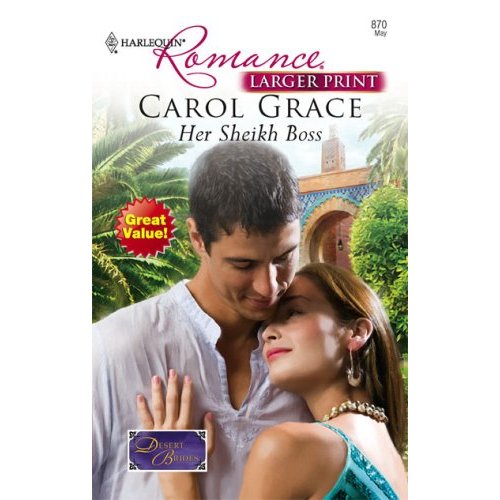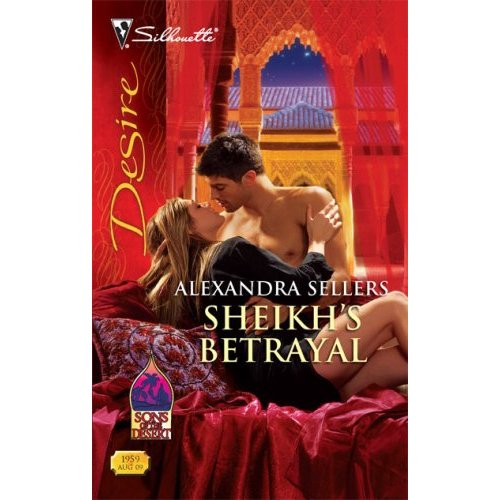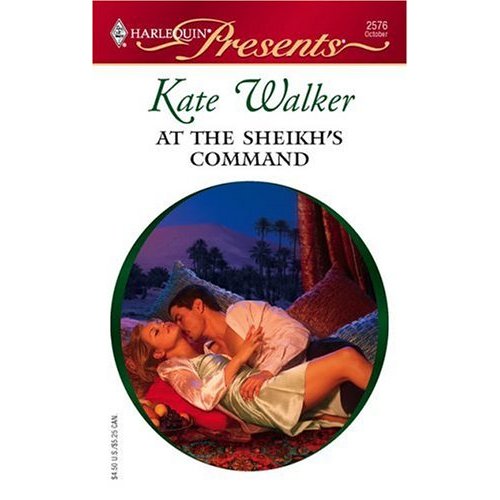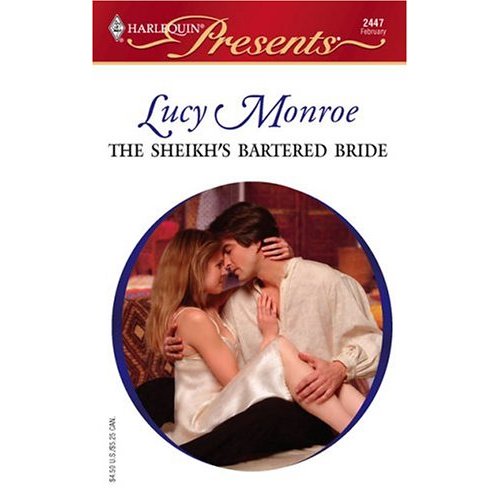Cross-posted at Jezebel.
In the article “And You Can Be My Sheikh: Gender, Race, and Orientalism in Contemporary Romance Novels,” Jessica Taylor discusses the “sheikh romance,” a type of romance novel that, Taylor argues, follows the following basic formula:
In an exotic land where it is rumoured that men still rule, a tall, dark and handsome sheikh meets a white woman who teaches him how to be ruled by love. (p. 1032)
Sheikh romances are generally set in fictional countries in the Middle East, with a male character described as a “sheikh,” “sultan,” or something along the lines of “king of the desert.” He is, of course, invariably rich and powerful. The female protagonist, on the other hand, is a White woman, usually from the U.S.
The topic is popular enough that Harlequin has a whole series, Desert Brides:
Another popular option is the Sons of the Desert series:
Taylor argues that these novels present a masculinized, exotic, and ultimately pre-modern Oriental Other that is contrasted with the modernized West.
Some examples:
The blurb, from Amazon (elipses in original):
When Sheikh Khalid Fehr rescues innocent Olivia Morse from the hands of his country’s enemies, he guarantees her freedom by announcing she is his betrothed….Khalid has vouched for Liv with his honor… and this desert king is determined that his new wife will fulfill her marital duties, by his side as his regal queen…and as his captive virgin bride!
Abbie Cavanaugh’s brother is in jail. Abbie can obtain his freedom—but only if she marries the Sheikh of Barakhara. The explosive passion between Prince Malik and Abbie could turn a marriage of convenience into one of Eastern promise. But neither Abbie nor Malik knows the other’s real identity. Can their marriage survive once the truth is revealed?
After a whirlwind courtship, Sheikh Hakim bin Omar al Kadar proposes marriage. Shy, innocent Catherine Benning has already fallen head-over-heels in love and she accepts….
After their wedding day–and night–when the sheikh claims his virgin wife, Catherine and Hakim travel to his desert kingdom. There Catherine discovers that this is no love match for Hakim–he’s bought her!
For more examples, go to Amazon and search “sheikh romance.” Seriously, there are tons of them — Traded to the Sheikh, Stolen by the Sheikh, The Desert Prince’s Mistress, The Sheikh’s Virgin, Love-Slave to the Sheikh, The Sheikh’s Ransomed Bride (notice the recurring economic transaction theme?), and my new personal favorite book title ever, Hired: The Sheikh’s Secretary Mistress, described thusly:
Sheikh Amir bin Faruq al Zorha lives in New York, but the desert is where his heart lies. Now it’s time for him to marry….Grace Brown, Amir’s plain but indispensable assistant, isn’t exactly queen material. No matter how tempted Amir is to take her innocence, she’s off-limits. Until he returns to his homeland, where the barbarian prince replaces the businessman—and resolves that Grace will be his!
Taylor argues that the themes of these books reflect concerns about gender relations while also setting up an East/West dichotomy in which Western (usually specifically U.S.) women tame the “barbarian” desires of non-Western men. The male love interests are too masculine for current U.S. cultural norms; they attempt to control women in an obvious manner, to force them into marriage, and/or to acquire them by purchase or trade.
But they are ultimately redeemable “barbarian princes.” On the cover, they’re darker than the (generally blond) woman, but only slightly so. They are usually described as having lived in the U.S. or Europe, often during college. They seek to “modernize” their countries, often signaled by their disinterest in or opposition to the harems still maintained by other men in their countries. Referring to harems clearly links this fictionalized Middle East to the past, while the individual hero instead chooses monogamy with one White woman, signaling his modernization.
A woman, and love, tame the dangerous but desirable hero. Interestingly, femininity here is presented as preferable not just for women, but for the male character as well, as a necessary element to balance his hypermasculinity:
…the man is brought to acknowledge the pre-eminence of love and the attractions of domesticity…the theme of category romance is female power…By getting the hero to give in and fall in love with her, and admit it, she brings him into the “feminine” world view…the heroine “civilizes” the Arab hero into a domestic love and he thus becomes an acceptable husband for a white girl. (p. 1046-47).
Ultimately, then, the sheikh romance presents a backward East, a state signaled largely by gender relations. There are two types of Middle Eastern men: those who are redeemable, who can be modernized, and those who can’t. And adoption of a certain ideal of monogamous romantic love, which renders the hero’s hypermasculinity exotic but no longer scary, provides the key to modernizing otherwise barbaric cultures.
The article is in Journal of Popular Culture v. 40, no. 6 (2007), p. 1032-1051.






Comments 77
AR — November 16, 2010
And, of course, they make light of slavery. It is my understanding that in real life, northern European slaves where highly valued for their beauty in the middle east during its respective golden age. Indeed, prior to the US Navy's campaign against Mediterranean piracy, white American women were still occasionally being captured and enslaved in north African harems.
I doubt any of those women found their situation romantic.
Ben — November 16, 2010
I'm not an expert on romance novels, so I'll defer to those who read and study them, but I wonder how much the gender roles in this Desert Brides series diverge from the gender roles portrayed in other Harlequin books and series.
Just from the books I've looked at, I'd say that in the quote "tall, dark and handsome sheikh meets a white woman who teaches him how to be ruled by love", sheikh can be replaced by:
*Scotsman
*Leveraged takeoff banker
*Victorian era robber baron
*Russian spymaster
*Skydiver
*Rabbi
Mo — November 16, 2010
Hence why I always take a romance novel or two when I go camping. I'm guaranteed never to run out of firestarters or toilet paper.
Sayantani DasGupta — November 16, 2010
Fabulous analysis! yet another twist on postcolonial critic Gayatri Chakrovorty Spivak's notion of "white men saving brown women from (backward) brown men" whereby 'saving' brown women from things like purdah, sati, etc. become ways of justifying colonial violence of "white men" against "brown men" (with the 'saved' brown women essentially having no say in the entire matter). This version of a frightening/sexist (Muslim) masculinity 'tamed' by white women is a very interesting counterpoint to the idea that the Afghan and Iraq wars are somehow justified by the idea that the West is 'freeing' Islamic women from 'the veil'. In addition, I think, there are echoes here of the construction of 'frightening' African American masculinity as well
I recently riffed on Orientalism in YA novels - the notion of India as a location of exotic fantasy, and questions of 'who has a right to speak for whom' here: http://storiesaregoodmedicine.blogspot.com/2010/11/hands-off-my-cultcha-should-only-ethnic.html
It's all related and clearly all stems from an Orientalist, racist, and colonial global framework...
--Sayantani
Amanda — November 16, 2010
The "sheik and the white virgin" books also usually portray the relationship as much more "he rules, she submits" than the rest of the romance genre. Often the storyline has him beat and/or rape her, and she loves him even more for it.
Morgan — November 16, 2010
Very true! It sparks several thoughts:
1. I wonder if, in the increasing climate of Islamophobia in the US recently, sales of these books have been affected? If so, in what direction?
2. There's a very striking similarity between the Sheik genre and a similar genre where the hero is Italian or Spanish- or Portuguese-speaking. These books are more often from the UK, but I've read American and Australian ones occasionally as well. The culture clash is the same, and the other culture is portrayed in much the same way (hyper-masculine), with the heroes always being stereotypically powerful and successful businessmen. Even much of the imagery is the same - lots of hot-vs-cold, and the descriptions of the heroes might lead you to believe that middle eastern and mediterranean men were indistinguishable. They typically also involve an obsession with virginity, attempts to buy the heroine, and a more "hot-blooded" (as opposed to savage, but it boils down to the same thing) masculine culture being civilized after falling in love with the more fragile and civilized Nice White Lady. I wonder if the Sheik subgenre might possibly be a branch of an older, already-established East-Meets-West subgenre that was originally focused on the Romance-language-speaking countries? Or perhaps vice-versa?
Lilac — November 16, 2010
The excerpts from the paper remind me of a lot of the research I've read about fanfic, especially how much of it stemmed from the "taming Captain Kirk" romances that women used to write. I wrote my own paper about fanfic back in college, and the number of stories wherein a woman tames the untameable man are innumerable. It always feels like the Harlequin romances are just a more accepted version of this idea.
Also, I used to work in a used bookstore, and the constant revolving door of romance novels was incredible. The amount of trade we did in those books far outweighed almost every other genre combined.
Village Idiot — November 16, 2010
Those books are the story of my life.
I too am a "son of the desert," having been born in Yuma, Arizona and I rescued my very own "desert bride" from a dysfunctional family living in a trailer park outside Albuquerque, New Mexico. However, several book publishers I've approached have shown no interest in developing my story into a novel, oddly enough.
[I did have a question about the first book cover: Does the phrase "Great Value!" printed on it refer to the number of words per penny you get, the number of bodices ripped per chapter, or is it some kind of quasi-subliminal suggestion from the marketing department?]
Sheihk Romances | brundlefly — November 16, 2010
[...] Sociological Images: In the article “And You Can Be My Sheikh: Gender, Race, and Orientalism in Contemporary Romance Novels,” Jessica Taylor discusses the “sheikh romance,” a type of romance novel that, Taylor argues, follows the following basic formula: In an exotic land where it is rumoured that men still rule, a tall, dark and handsome sheikh meets a white woman who teaches him how to be ruled by love. (p. 1032) [...]
Captain Pasty — November 16, 2010
I work in a library, and the whole Sheikh romance thing has really gotten more popular with the Mills and Boon romance books lately. Basically everyone at the library hates these books, and we make fun of them.
For the most part, the titles are all the same, with the male being described as: doctor, surgeon, french, itallian, greek, spanish, millionaire, billionaire, tycoon, sheikh, prince etc etc, and the woman being: innocent, virgin, mistress, nurse, mother. And their marriage is always something like: bargain, or, she is "bought".
Its really horrifying how many women read these books :S
Moji — November 16, 2010
I was born and grown up in the Middle East. First off I hate the term Middle East! It's called Aisa or Africa or whatever the name of the countries are. Is there anything like Middle West?? Anyway, Sheikhs do not look like what these novels depict. Sheikh is a term used for old people in tribes. So, I don't understand this whole handsome, young, sexy... thing.
conductress — November 16, 2010
Interesting. I think there's something much deeper going on than the male protagonists of these books not fitting modern US cultural norms. Most romances, if my understanding is correct, present similar protagonists--virile and marginally-violent men who are 'tamed' by love. These novels in the context of a post-9/11 society are very strange indeed.
Also, notice the covers. The men are not markedly or stereotypically Middle-Eastern. They're slightly darker skinned than the women, but they wear modern 'Western' clothing, don't have beards, wear turbans, or anything else that would mark them as a stereotypical Sheik. This is strange to me because covers being representative of the plot and characters is very important to readers, according to Jane Radway's work on romance novels. I wonder if publishers felt that stereotypical or markedly Middle Eastern men on the covers of books would be threatening, considering the West increasingly views Middle Eastern men as threats.
Aria — November 17, 2010
I think these are misogynist, orientalist, and racist, and women who are into these fantasies? Of 'domination but not too much'? 'Tolerable levels of romantic masculine domination'? Or whatever they perceive these stories as. I know I perhaps shouldn't, difference between fantasy/reality and all that, but I do judge them, for adding their 2 cents to perpetuating stereotypes about both women and Arabs.
Jesse — November 17, 2010
This is an okay article, but I wish the blogger would stop using 'masculine' or 'hypermasculine' as synonyms for 'wants to buy women' and 'might rape you'.
meerkat — November 17, 2010
Manga seems to have the same genre, except with gayness. (Maybe they have the heterosexual kind too but I haven't seen the covers while browsing through books.)
Kristin — November 17, 2010
HA! I just to happen to be writing an article about this very topic! (Popular, eh?)
The "modern" Sheikh books seem to just play off the general "Unapproachable Rich Man" theme that Harlequin likes to use. Just throw in a different Ethnicity or Job. Greeks, Sicilians, Businessmen, General European Royalty, etc. I'd be shocked if anyone at Harlequin knew what a Sheikh even was other than "Rich Arab guy" or "Prince William, except Arab".
The whole "inter-racial" aspect of these Sheikh books is interesting when you approach the "no mans land" of racial definition in the Arab community. Sarah Gualtieri discusses this in her book, "Between Arab and White" where Arabs are/ were seen as "white but not quite", particularly if they were Arab Christians from Syria or Lebanon & had a lighter skin tone. Sometimes in these Sheikh books, it turns out the dude has a white parent or in the case of "The Sheik" actually IS secretly white, therefore making their LURVE socially OK.
You will also notice that these romances never have the Heroines falling in love with a broke brown dude. The Greeks, Arabs and Sicilians all have to be rich or royalty in order for them to be doable. They don't get that "Rich only in Character" option like white Heros do. Money carries them over the line from "Brown Sex Object" to "Powerful Brown Marriage Material"
Molly W. — November 17, 2010
Though I'm an off-and-on romance reader, I haven't read widely in the sheikh genre -- probably a dozen or so over a 20-year span.
A few points that might add to the discussion:
-- Sheikh romances have been around for decades, and contemporary sheikh romances seem to be more influenced by the traditions of the format than they are by current events.
-- Also, US/UK relations with the Middle East were complicated well before 9/11. (Anyone remember the Iran hostage crisis of 1979-81?) Sept. 11 amplified certain stereotypes, but it didn't create them.
-- Many of the novels feature a villain -- often a bearded, turban-wearing, traditionalist -- who is counterposed to the Western-educated hero who wants to bring the benefits of the modern world to his people. (Please excuse the phrasing there, I'm trying to emulate how it would be expressed in the novels.) So the hero is presented as "uncivilized" by comparison to his English peers, but "civilized" compared to his peers in his own country. (There is SO MUCH to unpack there, I can't even begin ...)
-- Sheikh romances fit well within the conventions of Harlequin Presents, which is the line that tends to feature Greek tycoons, etc. There are lots of powerful magnates who force meek women to marry them by threatening their fathers with prison, etc. Harlequin Presents are a well-established line of category romances, but they only represent ONE TYPE of romance, a sort of modified contemporary Gothic.
-- There are many other well-selling subsets of the romance genre, many of which are considerably more progressive than sheikh romances. Rape fantasies are prevalent, but by no means all the genre has to offer. (Having said that: Try thinking of rape fantasy romances as BDSM erotica-lite.)
-- Romance fiction is not a niche; per the Romance Writers Assn, it has the largest market share of any genre (13 percent). Back in the late 1980s, they had stats claiming 50 million American women regularly read romance fiction.
Jenn — November 17, 2010
I highly recommend the blog "Smart Bitches, Trashy Novels" or "Dear Author" if you're interested in learning more about romance novels. Both sites have compelling and interesting takes on the genre and address many of the issues raised by comments on this posting.
http://www.smartbitchestrashybooks.com/index.php
http://dearauthor.com/
A — November 17, 2010
I think the slightly disturbing thing IS the way these Middle Eastern men are de-Islamicized. (Someone did mention this above.) It's like-- Oh I want a dark and sexy lover, but I want him to have no vestiges of a different religion and only stock characterizations of his culture. But, truly, romance novels are the ultimate fantasy novels, so I sort of give them a break. If girls don't want Islam interfering with their romance experience, that's their choice. It might indicate something in their subconscious, but that doesn't necessarily intrude into their actions.
What is interesting to me is related to the thesis of Taylor's article. The East is generally feminized in our culture, but in this female-dominated genre, the East is hyper-masculinized. Essentially, the East is always Othered (either made feminine or made masculine) by Western sources. So if it still tends to be feminized in literature, film, TV, etc., what does that say about who is still in control of our culture?
A — November 18, 2010
Just for wiki sake...
http://en.wikipedia.org/wiki/Sheikh
Those images are definitely not the images that come to mind when I think of shiekh. That's what I find odd.
nina — November 18, 2010
This is quite typical of romance novels. Whatever the ethnicity of the other, the story plays out the same.He may be an invading Norman, he may be a fierce Native American, he may be a cruel Viking, he may even be of the same race and ethnicity as the female but of a different subculture- detective watching her house after a robbery,rough mean biker dude who kidnapped her by mistake, cowboy riding through the plains looking for temporary work on a ranch, super controlled emotionless businessman who has to work with the flaky hippy heiress to his partners shares.
I'm not dismissing the race issue at all, just saying that regardless of the race or nationality or ethnicity of the man, he is usually an Other of some sort and the story plays out the same every time.
Peter Tupper — November 20, 2010
This goes back well before Edith Maude Hull's novel in 1919. "The Lustful Turk" was an anonymous pornographic novel published in England in 1828, inspired by the Greek Rebellion of the 1920s.
There are lots of cases of real-world, historical conflicts being used as inspiration for romantic or pornographic texts. Sometimes its male=West/female=East, other times it is female=West/male=East.
Action Librarian » NaArWriMo not a complete NaArFAILMo — November 29, 2010
[...] It has been done. Like LOTS of times. [...]
back after a long hiatus « The Ultimate Sheikh Fan Blog — February 2, 2011
[...] http://thesocietypages.org/socimages/2010/11/16/racial-and-gender-themes-in-sheikh-romances/ [...]
Steppe — July 20, 2011
Yeah those are kind of offensive. I think you are right in saying that it is supposed to show the common theme of the woman taming the wild man and the writers just chose sheikhs to represent this but there are just as many of these books where the barbarian is presented as other "wild" races.
http://www.ravenouromance.com
Anonymous — February 25, 2021
I want to try to imagine a harsh and tough world in which women fight for basic human rights, the economic situation is shaky, and technological advances are the subject of conversation. You can learn more in detail from the article https://ponbee.com/the-story-of-an-hour-quotes/ in which the topic The Story of an Hour is just discussed. Marriage in those days was a means of social control. It helped to keep women in check and helped to consolidate the social and political power of men.
Weekly Round-Up, 26 January - 1 February 2022: Pokemon Legends, Tokyopop Anniversary, and Penguindrum - Anime Feminist — February 1, 2022
[…] clumsy hyping up of Rudolph Valentino’s Ahmed in 1921’s The Sheikh, a “period typical” racist performance, doesn’t just reframe the film as empowering and erotic. It’s also the only real engagement of […]